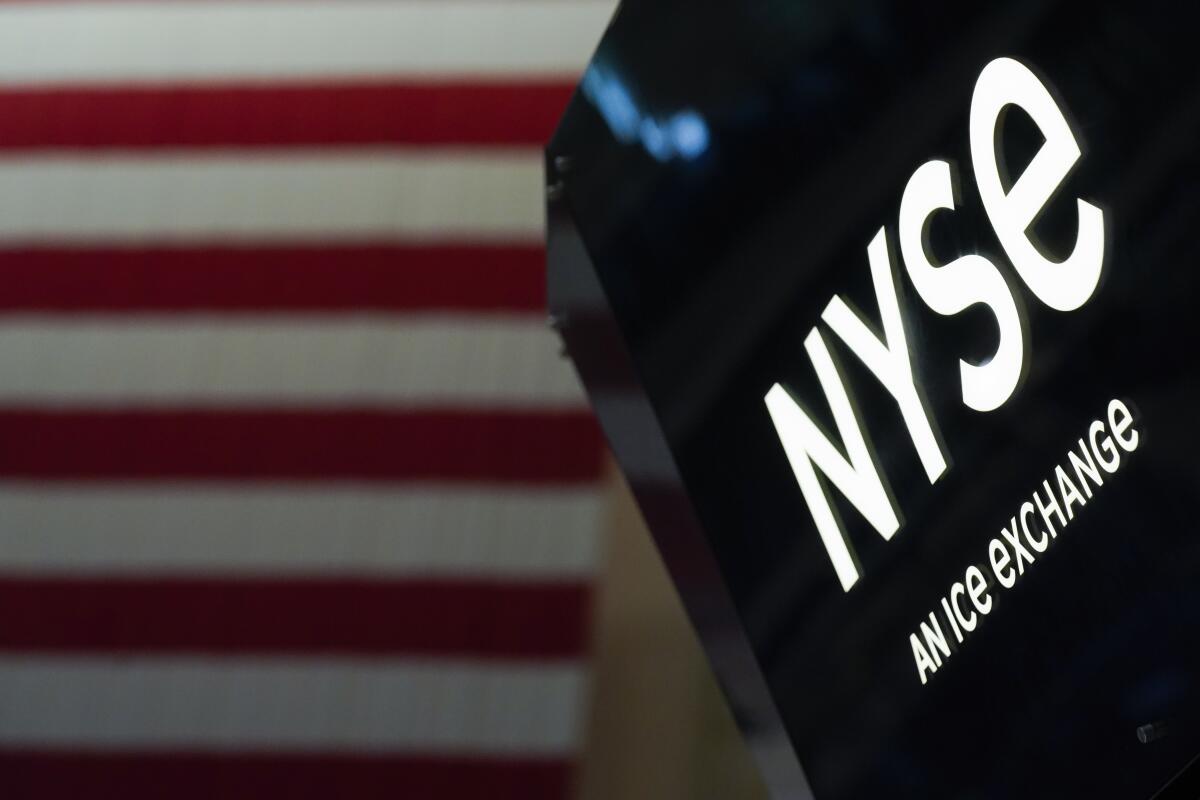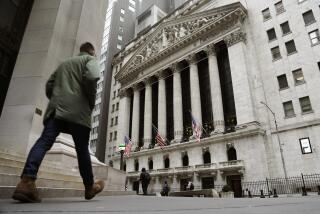Wall Street swings after inflation data, ends little changed

- Share via
Stocks swung through shaky trading Thursday after the latest update on inflation across the U.S., only to end up roughly where they started.
The Standard & Poor’s 500 edged up by 1.12 points, or less than 0.1%, to 4,468.83. It was just the second winning day for the index in the last eight, but it had been up 1.3% in the morning before wobbling between small gains and losses.
The Dow Jones gained 52.79 points, or 0.2%, to 35,176.15 after giving up most of a morning gain of 455 points, and the Nasdaq composite added 15.97 points, or 0.1%, to close at 13,737.99.
Thursday’s highly anticipated inflation report showed U.S. consumers paid prices that were 3.2% higher in July than a year earlier. That’s a touch milder than the 3.3% inflation rate economists expected to see and down sharply from last summer’s peak above 9%. Beneath the surface, underlying trends for inflation were also within expectations.
The readings bolstered hopes among investors that the Federal Reserve’s campaign to grind down inflation is progressing and that maybe it could even be done raising interest rates. High rates undercut inflation by slowing the entire economy and hurting investment prices, which raise the risk of a recession.
Such hopes helped the S&P 500 rally 19.5% through the first seven months of the year, though critics say Wall Street too quickly formed a consensus that inflation is continuing to cool, the economy will avoid a recession and the Fed has already raised rates for the final time this cycle. Several economists said again Thursday that future moves by the Fed are still uncertain, tamping down some enthusiasm.
Some teachers are turning to social media to afford supplies and help make their classrooms more equitable.
The Fed has said it will make upcoming decisions on rates based on what data reports say, particularly those on inflation and the job market. Its main rate is already at its highest level in more than two decades.
Thursday’s report probably gives the Fed a reason to hold rates steady at its next meeting in September, before it gets more economic data in the run-up to the following meeting, which ends Nov. 1, said Gargi Chaudhuri, head of iShares Investment Strategy, Americas.
“Separating the signal from the noise, most of the components of inflation are heading in the right direction,” said Brian Jacobsen, chief economist at Annex Wealth Management. He said if the trends continue, it will be tough to justify another interest rate increase.
Of course, another report on inflation is looming Friday, which will show how bad inflation was in July at the wholesale level. Then, more reports on inflation and one more on overall hiring for August will arrive before the Fed’s next meeting, which ends Sept. 20.
Treasury yields in the bond market initially fell after the inflation data along with a report that showed slightly more workers applied for unemployment benefits last week than expected.
Consumers are switching grocery stores, brands and ingredients as they try to cope with the cost of food.
Fed officials would probably welcome some softening of the job market, which has remained remarkably resilient despite much higher interest rates. That’s because a looser job market could remove upward pressure on inflation.
The weekly data on unemployment claims, though, have given head fakes in the past about the trajectory of the job market, said Mike Loewengart, head of model portfolio construction at Morgan Stanley Global Investment Office. That could mean the interest rate cuts that investors really desire may be further off than hoped.
“The Fed may leave interest rates unchanged next month, but they’re not about to start cutting them,” Loewengart said.
Big U.S. companies, meanwhile, continue to report mostly better profits for the spring than analysts expected. That’s usually the case, and analysts had particularly low expectations coming into this reporting season as higher costs for workers and other expenses eat into profit margins.
Walt Disney rose 4.9% after saying it would raise prices for some of its streaming services in hopes of boosting profitability. The entertainment giant reported stronger profit for the spring than analysts expected but weaker revenue.
Capri Holdings — which owns the Michael Kors, Versace and Jimmy Choo brands — soared 55.7% as Big Fashion continues to consolidate.
Tapestry, the company behind luxury handbag and accessories retailer Coach, said it was buying Capri for roughly $8.5 billion. The deal would put it in better position to take on big European rivals, such as LVMH. Tapestry fell 15.9%.
In the bond market, Treasury yields rose in the afternoon after an auction by the U.S. government of 30-year Treasury bonds. Yields have been generally rising recently amid concerns about heavy borrowing by the federal government. Those higher yields add pressure on the stock market.
In the bond market, the yield on the 10-year Treasury rose to 4.09% from 4.01% late Wednesday. It helps set rates for mortgages and other important loans.
The two-year Treasury yield, which moves more on expectations for the Fed, ticked up to 4.81% from 4.80%.
In stock markets abroad, indexes were higher in Europe and mixed in Asia.
Stocks in China held relatively steady after President Biden signed an order to block and regulate high-tech U.S.-based investments going toward China.
AP writers Yuri Kageyama and Matt Ott contributed to this report.
More to Read
Inside the business of entertainment
The Wide Shot brings you news, analysis and insights on everything from streaming wars to production — and what it all means for the future.
You may occasionally receive promotional content from the Los Angeles Times.












